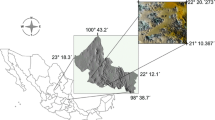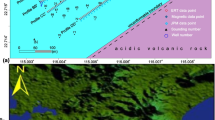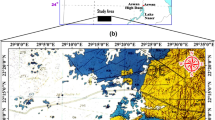Abstract
Fracture and fault networks are conduits that facilitate groundwater movement in hard-rock terrains. Soil-gas helium emanometry has been utilized in Wailapally watershed, near Hyderabad in southern India, for the detection of fracture and fault zones in a granite basement terrain having a thin regolith. Based on satellite imagery and geologic mapping, three sites were selected for detailed investigation. High spatial resolution soil-gas samples were collected at every one meter at a depth of >1.5m along 100m long profiles (3 in number). In addition, deep shear-wave images were also obtained using the multichannel analysis of surface waves. The study clearly indicates several soil-gas helium anomalies (above 200 ppb) along the profiles, where the shear-wave velocity images also show many near-surface vertical low velocity zones. We thus interpret that the soil-gas helium anomalous zones and the vertical low-velocity zones are probable traces of fault/fracture zones that could be efficient natural recharge zones and potential groundwater conduits. The result obtained from this study demonstrates the efficacy of an integrated approach of soil-gas helium and the seismic methods for mapping groundwater resource zones in granite/gneiss provinces.
Similar content being viewed by others
References
Chadwick B, Vasudev V N and Hegde G V 2000 The Dharwar craton, southern India, interpreted as the result of late Archaean oblique convergence; Precamb. Res. 99 91–111.
Condie K C 1993 Chemical composition and evolution of the upper continental crust: Contrasting results from surface samples and shales; Chem. Geol. 104 1–37.
Gascoyne M, Wuschke D M and Durrance E M 1993 Fracture detection and ground water flow characterization using He and Rn in soil gases, Manitoba, Canada; Appl. Geochem. 8 223–233.
Gupta H K, Rao R UM, Srinivasan R, Rao G V, Reddy G K, Dwivedy K, Banerjee D, Mohanty R and Satyasaradhi Y 1999 Anatomy of surface rupture zones of two stable continental region earthquakes, 1967 Koyna and 1993 Latur, India; Geophys. Res. Lett. 26 1985–1988.
Kumar P S and Reddy G K 2004 Radioelements and heat production of an exposed Archaean crustal cross-section, Dharwar Craton, south India; Earth Planet. Sci. Lett. 224 309–324.
Miller R D, Xia J, Park C B and Ivanov J 1999 Multichannel analysis of surface waves to map bedrock; The Leading Edge 18 1392–1396.
Park C B, Miller R D and Xia J 1999 Multi-channel analysis of surface waves; Geophysics 64 800–808.
Rao G V, Reddy G K, Rao R U M and Gopalan K 1994 Extraordinary helium anomaly over surface rupture of September 1993 Killari earthquake; Curr. Sci. 66 933–935.
Reimer G M 1985 Prediction of central California earthquakes from soil-gas fluctuations; Pure Appl. Geophys. 122 369–375.
Seshunarayana T, Prasad P P, Rao S V P P and Kousalya M 2006 Seismic surveys for earthquake microzonation of Jabalpur — A case study; In: Earthquake Mitigation, Preparedness, Seismic Vulnerability Assessment, National workshop on earthquake resistant design for the built environment (eds) Chapter T S et al 4.3.1.
Seshunarayana T, Senthil Kumar P, Sampath Rao V, Mysaiah D, Satish Kumar K and Pavan Kishore P 2008a Multichannel analysis of surface waves reveals shear zones and fractures in a shallow granite basement: Wailapally watershed near Hyderabad; J. Geol. Soc. India 71 261–265.
Seshunarayana T, Satish Kumar K, Deenanadh S, Rama Mohan Rao Y and Senthil Kumar P 2008b Subsurface imaging of dolerite dykes in Hyderabad granite terrain using multichannel analysis of surface waves, In: Indian Dykes (eds) R K Srivastava, Ch Sivaji and N V Chalapathi Rao (New Delhi: Narosa Publishing House) pp. 331–338.
Toutain J-P and Baubron J-C 1999 Gas geochemistry and seismotectonics: A review; Tectonophys. 304 1–27.
Xia J, Miller R D, Park C B and Tian G 2002 Determining Q of near-surface materials from Rayleigh waves; J. Appl. Geophys. 51 121–129.
Xu C and Butt S D 2006 Evaluation of MASWtechniques to image steeply dipping cavities in laterally inhomogeneous terrain; J. Appl. Geophys. 59 106–116.
Xu Y, Xia J and Miller R D 2006 Quantitative estimation of minimum offset for multichannel surface-wave survey with actively exciting source; J. Appl. Geophys. 59 117–125.
Author information
Authors and Affiliations
Corresponding author
Rights and permissions
About this article
Cite this article
Reddy, G.K., Seshunarayana, T., Menon, R. et al. Soil-gas helium and surface-waves detection of fault zones in granitic bedrock. J Earth Syst Sci 119, 745–751 (2010). https://doi.org/10.1007/s12040-010-0047-0
Received:
Revised:
Accepted:
Published:
Issue Date:
DOI: https://doi.org/10.1007/s12040-010-0047-0




